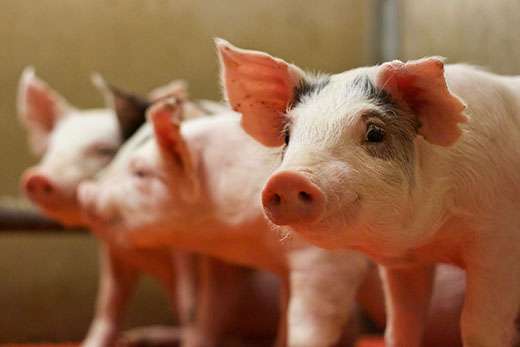Calcium to phosphorus ratio in pig diets established by new study

The amount of digestible calcium included in pig diets has a direct impact on phosphorus digestibility, but the optimum ratio between the two minerals has not yet been found. In a recent study from the University of Illinois, scientists have established a first approximation of that ratio for 25 to 50 kilogram pigs.
"Because calcium is an inexpensive ingredient, the thinking was that we could add as much as we wanted. We discovered several years ago that may not be a good approach, because if you increase calcium in the diet, you reduce absorption of phosphorus," says Hans Stein, professor in the Department of Animal Sciences and the Division of Nutritional Sciences at U of I. "As phosphorus availability goes down, so does the pigs' growth performance. Feed intake, and therefore body weight gain and feed efficiency, goes down."
Stein and his collaborators formulated 20 corn-soybean meal-based diets, varying in calcium and phosphorus concentration, and fed them to 240 pigs over four weeks. Diets were formulated to contain 0.15, 0.31, 0.39, or 0.47 percent standardized total tract digestible (STTD) phosphorus and 0.13, 0.27, 0.42, 0.57, or 0.72 percent STTD calcium. These values represented 48 to 152 percent of the STTD phosphorus requirement and 27 to 173 percent of the total calcium requirement.
By the end of the four-week trial, the researchers were able to determine pig growth performance, in terms of average daily gain and gain to feed, as well as incorporation of the minerals into bone.
In a separate trial, 120 pigs were fed the same 20 diets for two weeks. For these animals, urine, fecal, and blood samples were analyzed for calcium and phosphorus concentrations.
"The results confirmed what we've seen before. If you feed too much calcium, in particular with low or marginal phosphorus in the diet, pig growth performance goes down," Stein says. "We still need to do more work to determine the optimum ratio between the two, but we have definitely confirmed that the ratio is very important."
Stein says most pig diets are currently formulated with marginal phosphorus, partly due to cost of the ingredient and partly because producers want to avoid having to mitigate excreted phosphorus in manure. But diets formulated with too much calcium or too little phosphorus could be reducing pig growth performance.
"If someone asked us today, we would say that to maximize average daily gain and gain to feed for 25 to 50 kg pigs, the ratio of STTD calcium to STTD phosphorus should be between 1.16:1 and 1.43:1. However, it is possible that we will have to change that ratio as we get more data. It is still very early," Stein says.
The article, "Requirements for digestible calcium by 25 to 50 kg pigs at different dietary concentrations of phosphorus as indicated by growth performance, bone ash concentration, and calcium and phosphorus balances," is published in the Journal of Animal Science.
More information: J. C. González-Vega et al. Requirement for digestible calcium by 25 to 50 kg pigs at different dietary concentrations of phosphorus as indicated by growth performance, bone ash concentration, and calcium and phosphorus balances, Journal of Animal Science (2016). DOI: 10.2527/jas.2016-0751
Journal information: Journal of Animal Science
Provided by University of Illinois at Urbana-Champaign















